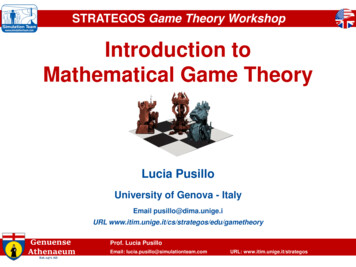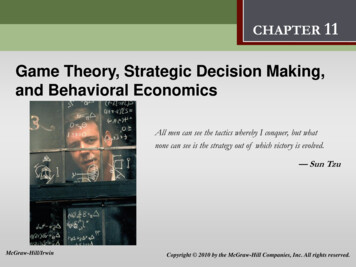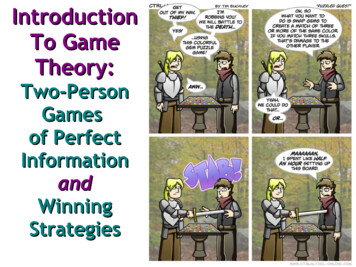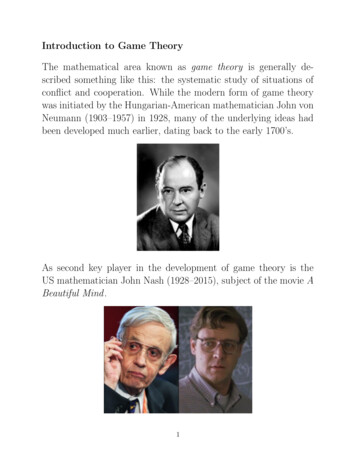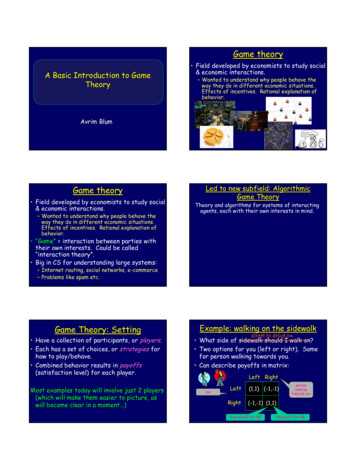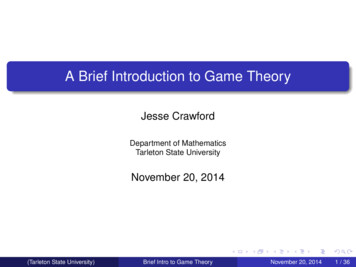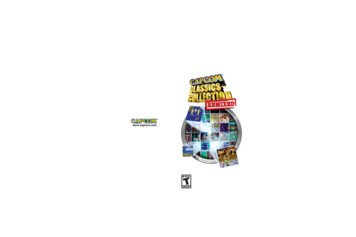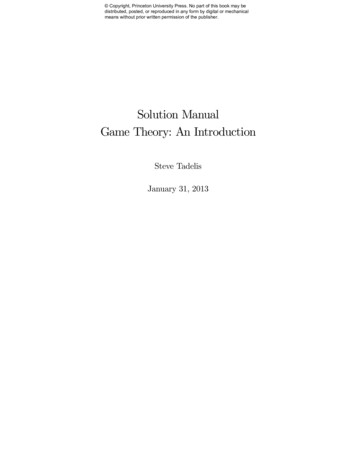
Transcription
Copyright, Princeton University Press. No part of this book may bedistributed, posted, or reproduced in any form by digital or mechanicalmeans without prior written permission of the publisher.Solution ManualGame Theory: An IntroductionSteve TadelisJanuary 31, 2013
Copyright, Princeton University Press. No part of this book may bedistributed, posted, or reproduced in any form by digital or mechanicalmeans without prior written permission of the publisher.ABSTRACT This Solution Manual includes only the even numbered questions andis available for public access. It is still incomplete. It will be updated every 2-3 weeksto add the solutions to problems as they become available. A complete version isexpected by March 15, 2013.
Copyright, Princeton University Press. No part of this book may bedistributed, posted, or reproduced in any form by digital or mechanicalmeans without prior written permission of the publisher.ContentsIRational Decision Making21 The Single-Person Decision Problem32 Introducing Uncertainty and Time9IIStatic Games of Complete Information213 Preliminaries234 Rationality and Common Knowledge275 Pinning Down Beliefs: Nash Equilibrium356 Mixed Strategies51
Copyright, Princeton University Press. No part of this book may bedistributed, posted, or reproduced in any form by digital or mechanicalmeans without prior written permission of the publisher.ContentsIIIDynamic Games of Complete Information1627 Preliminaries638 Credibility and Sequential Rationality73
Copyright, Princeton University Press. No part of this book may bedistributed, posted, or reproduced in any form by digital or mechanicalmeans without prior written permission of the publisher.Part IRational Decision Making2
Copyright, Princeton University Press. No part of this book may bedistributed, posted, or reproduced in any form by digital or mechanicalmeans without prior written permission of the publisher.1The Single-Person Decision Problem1.2. Going to the Movies: There are two movie theatres in your neighborhood: Cineclass, which is located one mile from your home, and Cineblast,located 3 miles from your home, each showing three films. Cineclass is showing Casablanca, Gone with the Wind and Dr. Strangelove, while Cineblastis showing The Matrix, Blade Runner and Aliens. Your problem is to decidewhich movie to go to.(a) Draw a decision tree that represents this problem without assigningpayoff values.Answer:
Copyright, Princeton University Press. No part of this book may bedistributed, posted, or reproduced in any form by digital or mechanicalmeans without prior written permission of the publisher.41. The Single-Person Decision Problem (b) Imagine that you don’t care about distance and that your preferencesfor movies is alphabetic (i.e., you like Aliens the most and The Matrixthe least.) Using payoff values 1 through 6 complete the decision treeyou drew in part (a). What option would you choose?Answer: (c) Now imagine that your car is in the shop, and the cost of walking eachmile is equal to one unit of payoff. Update the payoffs in the decisiontree. Would your choice change?Answer: 3.4. Alcohol Consumption: Recall the example in which you needed to choosehow much to drink. Imagine that your payoff function is given by 4 2
Copyright, Princeton University Press. No part of this book may bedistributed, posted, or reproduced in any form by digital or mechanicalmeans without prior written permission of the publisher.1. The Single-Person Decision Problem5where is a parameter that depends on your physique. Every person mayhave a different value of , and it is known that in the population ( ) thesmallest is 0 2; ( ) the largest is 6; and ( ) larger people have higher ’sthan smaller people.(a) Can you find an amount of drinking that no person should drink?Answer: The utility from drinking 0 is equal to 0. If a decision makerdrinks 2 then, if he has the largest 6, his payoff is 6 2 4 (2)2 4 and it is easy to see that decision makers with smallervalues of will obtain an even more negative payoff from consuming 2. Hence, no person should choose 2. (b) How much should you drink if your 1? If 4?Answer: The optimal solution is obtained by maximizing the payofffunction ( ) 4 2 . The first-order maximization condition is 8 0 implying that 8 is the optimal solution. For 1 thesolution is 18 and for 4 it is 12 . (c) Show that in general, smaller people should drink less than larger people.Answer: This follows from the solution in part (b) above. For everytype of person , the solution is ( ) 8 which is increasing in , andlarger people have higher values of (d) Should any person drink more than one bottle of wine?Answer: No. Even the largest type of person with 6 should onlyconsume 34 of a bottle of wine. 5.6. Fruit Trees: You have room for up to two fruit bearing trees in your garden.The fruit trees that can grow in your garden are either apple, orange or pear.The cost of maintenance is 100 for an apple tree, 70 for an orange tree and 120 for a pear tree. Your food bill will be reduced by 130 for each apple
Copyright, Princeton University Press. No part of this book may bedistributed, posted, or reproduced in any form by digital or mechanicalmeans without prior written permission of the publisher.61. The Single-Person Decision Problemtree you plant, by 145 for each pear tree you plant and by 90 for eachorange tree you plant. You care only about your total expenditure in makingany planting decisions.(a) What is the set of possible actions and related outcomes?Answer: You have two “slots” that can be left empty, or have one of 3possible trees planted in each slot. Hence, you have 10 possible choices.1The outcomes will just be the choices of what to plant. (b) What is the payoff of each action/outcome?Answer: To calculate the payoffs from each choice it is convenient touse a table as follows:Choicecost food savings net payoffnothing000one apple tree10013030one orange tree709020one pear tree12014525two apple trees20026060two orange trees 14018040two pear trees24029050apple and orange 17022050apple and pear22027555pear and orange 19023545(c) Which actions are dominated?Answer: All but choosing two apple trees are dominated. (d) Draw the associated decision tree. What will a rational player choose?Answer: The tree will have ten branches with the payoffs associatedwith the table above, and the optimal choice is two apple trees. 1 This(4 2 1)!2!(4 1)!is a probem of choosing 2 items out of 4 possibilities with replacement, which is equal to 5 4 10.2 4 2 1 2
Copyright, Princeton University Press. No part of this book may bedistributed, posted, or reproduced in any form by digital or mechanicalmeans without prior written permission of the publisher.1. The Single-Person Decision Problem7(e) Now imagine that the food bill reduction is half for the second tree ofthe same kind (you like variety). That is, the first apple still reducesyour food bill by 130, but if you plant two apple trees your food billwill be reduced by 130 65 195. (Similarly for pear and orangetrees.) What will a rational player choose now?Answer: An apple tree is still the best choice for the first tree, but nowthe second tree should be a pear tree.
Copyright, Princeton University Press. No part of this book may bedistributed, posted, or reproduced in any form by digital or mechanicalmeans without prior written permission of the publisher.81. The Single-Person Decision Problem
Copyright, Princeton University Press. No part of this book may bedistributed, posted, or reproduced in any form by digital or mechanicalmeans without prior written permission of the publisher.2Introducing Uncertainty and Time1.2. Recreation Choices: A player has three possible venues to choose from:going to a football game, going to a boxing match, or going for a hike.The payoff from each of these alternatives will depend on the weather. Thefollowing table gives the agent’s payoff in each of the two relevant weatherevents:Alternativepayoff if Rain payoff if ShineFootball game12Boxing Match30Hike01For Let denote the probability of rain.(a) Is there an alternative that a rational player will never take regardlessof ? (i.e., it is dominated for any [0 1].)Answer: For this decision maker choosing the hike is always worse(dominated) by going to the football game, and he should never go ona hike.
Copyright, Princeton University Press. No part of this book may bedistributed, posted, or reproduced in any form by digital or mechanicalmeans without prior written permission of the publisher.102. Introducing Uncertainty and Time(b) What is the optimal decision, or best response, as a function of .Answer: The expected payoffs from each of the remaining two choicesare given by, (Football) 1 (1 ) 2 2 (Boxing) 3 (1 ) 0 3 which implies that football is a better choice if and only if2 3 or, 12 , and boxing is better otherwise. 3.4. Drilling for Oil: An oil drilling company must decide whether or not toengage in a new drilling activity before regulators pass a law that bans drillingat that site. The cost of drilling is 1,000,000. After drilling is completed andthe drilling costs are incurred, then the company will learn if there is oil ornot. If there is oil, operating profits generated are estimated at 4,000,000.If there is no oil, there will be no future profits.(a) Using to denote the likelihood that drilling results in oil, draw thedecision tree of this problem.Answer: Two decision branches: drill or not drill. Following drilling,Nature chooses oil with probability , with the payoff of 3 million (4minus the initial investment). With probability 1 Nature choosesno-oil with a payoff 1 million. (b) The company estimates that 0 6. What is the expected value ofdrilling? Should the company go ahead and drill?Answer: The expected payoff (in millions) from drilling is 3 (1 ) 1 4 1 0 6, which means that the company should drill.
Copyright, Princeton University Press. No part of this book may bedistributed, posted, or reproduced in any form by digital or mechanicalmeans without prior written permission of the publisher.2. Introducing Uncertainty and Time11(c) To be on the safe side, the company hires a specialist to come up with amore accurate estimate of . What is the minimum vale of for whichit would be the company’s best response to go ahead and drill?Answer: The minimum value of for which drilling causes no expectedloss is calculated by solving 3 (1 ) 1 0, or 14 5.6. Real Estate Development: A real estate developer wishes to build a newdevelopment. Regulations impose an environmental impact study that willyield an “impact score,” which is an index number based on the impact thedevelopment will likely have on traffic, air quality, sewage and water usage,etc. The developer, who has lots of experience, knows that the score willbe no less than 40, and no more than 70. Furthermore, he knows that anyscore between 40 and 70 is as likely as any other score between 40 and 70(use continuous values). The local government’s past behavior implies thatthere is a 35% chance that it will approve the development if the impactscore is less than 50, a 5% chance that it will approve the development ifthe score is between 50 and 55, and if the score is greater than 55 then theproject will surely be halted. The value of the development to the developer is 20,000,000. Assuming that the developer is risk neutral, what is themaximum cost of the impact study such that it is still worthwhile for thedeveloper to have it conducted?Answer: Observe that there is a 13 probability of getting a score between40 and 50 given that 40 to 50 is one-third of the range 40 to 70. There isa 16 probability of getting a score between 50 and 55 given that 50 to 55 isone-sixth of the range 40 to 70. Hence, the expected value of doing a studyis111 35 20 000 000 05 20 000 000 0 20 000 000362 2 500 000Hence, the most the developer should pay for the study is 2,500,000.
Copyright, Princeton University Press. No part of this book may bedistributed, posted, or reproduced in any form by digital or mechanicalmeans without prior written permission of the publisher.122. Introducing Uncertainty and Time7.8. Juice: Bozoni is a renowned Swiss maker of fruit and vegetable juice, whoseproducts are sold at specialty stores around Western Europe. Bozoni is considering whether to add cherimoya juice to its line of products. “It wouldbe one of our more difficult varieties to produce and distribute,” observesJohann Ziffenboeffel, Bozoni’s CEO. “The cherimoya would be flown in fromNew Zealand in firm, unripe form, and it would need its own dedicated ripening facility here in Europe.” Three successful steps are absolutely necessaryfor the new cherimoya variety to be worth producing. The industrial ripening process must be shown to allow the delicate flavors of the cherimoyato be preserved; the testing of the ripening process requires the buildingof a small-scale ripening facility. Market research in selected small regionsaround Europe must show that there is sufficient demand among consumersfor cherimoya juice. And cherimoya juice must be shown to withstand theexisting tiny gaps in the cold chain between the Bozoni plant and the endconsumers (these gaps would be prohibitively expensive to fix). Once thesethree steps have been completed, there are about 2,500,000 worth of expenses in launching the new variety of juice. A successful new variety willthen yield profits, in expected present-value terms, of 42.5 million.The three absolutely necessary steps can be done in parallel or sequentiallyin any order. Data about these three steps is given in Table 1. “Probabilityof success” refers to how likely it is that the step will be successful. If it is notsuccessful, then that means that cherimoya juice cannot be sold at a profit.All probabilities are independent of each other (i.e., whether a given step issuccessful or not does not affect the probabilities that the other steps will besuccessful). “Cost” refers to the cost of doing this step (regardless of whetherit is successful or not).(a) Suppose Mr. Ziffenboeffel calls you and asks your advice about theproject. In particular, he wants to know (i) should he do the threenecessary steps in parallel (i.e., all at once) or should he do them sequentially; and (ii) if sequentially, what’s the right order for the steps
Copyright, Princeton University Press. No part of this book may bedistributed, posted, or reproduced in any form by digital or mechanicalmeans without prior written permission of the publisher.2. Introducing Uncertainty and Time13to be done? What answers do you give him?Answer: Bozoni should do the steps sequentially in this order: first testthe cold chain, then the ripening process, then do the test-marketing.The expected value of profits is 1.84 million. Observe that it would notbe profitable to launch the product if Bozoni had to do all the stepssimultaneously. This is an example of real options–by sequencing thesteps, Bozoni creates options to switch out of a doomed project beforetoo much money gets spent. (b) Mr. Ziffenboeffel calls you back. Since Table 1 was produced (see below),Bozoni has found a small research firm that can perform the necessarytests for the ripening process at a lower cost than Bozoni’s in-houseresearch department.Table 1: Data on launching the Cherimoya juiceStepProbability of success CostRipening process0.7 1,000,000Test marketing0.3 5,000,000Cold chain0.6 500,000At the same time, the EU has raised the criteria for getting approvalfor new food producing facilities, which raises the costs of these tests.Mr. Ziffenboeffel would, therefore, like to know how your answer to (a)changes as a function of the cost of the ripening test. What do you tellhim?Answer: This is sensitivity analysis for the cost of testing the ripeningprocess. This can be done by varying the cost for ripening, and seeingwhich expected payoff (highlighted yellow) is highest for which values ofthe cost. For example, whenever we set the cost below 375,000 it turnsout that the payoff from the sequence gives the highestpayoff among the six possible sequences. (Excel’s GoalSeek is a particularly handy way for finding the threshold values quickly).Specifically, the optimal sequence is
Copyright, Princeton University Press. No part of this book may bedistributed, posted, or reproduced in any form by digital or mechanicalmeans without prior written permission of the publisher.142. Introducing Uncertainty and Timei) if the cost of 375 000ii) if the cost of 375 000 2 142 857iii) if the cost of 2 142 857 8 640 000iv) don’t launch if costs more than 8 640 000where “ ” stands for the ripening process, “ ” stands for the coldchain, and “ ” stands for test marketing. (c) Mr. Ziffenboeffel calls you back yet again. The good news is the EUregulations and the outsourcing of the ripening tests “balance” eachother out, so the cost of the test remains 1,000,000. Now the problemis that his marketing department is suggesting that the probability thatthe market research will result in good news about the demand couldbe different in light of some recent data on the sales of other subtropicalfruit products. He would, therefore, like to know how your answer to(a) changes as a function of the probability of a positive result from themarket research. What do you tell him?Answer: This can be found by varying the probability of success fortest marketing (highlighted by blue in the excel sheet) between 0 and1. The optimal sequence turns out to bei) don’t launch if 0 1905ii) if 0 1905where is the probability that the test marketing will be successful. 9.10. Surgery: A patient is very sick, and will die in 6 months if he goes untreated.The only available treatment is risky surgery. The patient is expected to livefor 12 months if the surgery is successful, but the probability that the surgeryfails and the patient dies immediately is 0.3.
Copyright, Princeton University Press. No part of this book may bedistributed, posted, or reproduced in any form by digital or mechanicalmeans without prior written permission of the publisher.2. Introducing Uncertainty and Time15(a) Draw a decision tree for this decision problem.Answer: Using ( ) to denote the value of living more months, thefollowing is the decision tree: (b) Let ( ) be the patient’s payoff function, where is the number ofmonths till death. Assuming that (12) 1 and (0) 0, what is thelowest payoff the patient can have for living 3 months so that havingsurgery is a best response?Answer: The expected value of the surgery given the payoffs above is [ (surgery)] 0 7 (12) 0 3 (0) 0 7which implies that if (3) 0 7 then the surgery should be performed. For the rest of the problem, assume that (3) 0 8.(c) A test is available that will provide some information that predictswhether or not surgery will be successful. A positive test implies anincreased likelihood that the patient will survive the surgery as follows:True-positive rate: The probability that the results of this test willbe positive if surgery is to be successful is 0.90.False-positive rate: The probability that the results of this test willbe positive if the patient will not survive the operation is 0.10.What is the probability of a successful surgery if the test is positive?Answer: The easiest way to think about this is to imagine that theoriginal 0.7 probability of success is true because for 70% of the sick
Copyright, Princeton University Press. No part of this book may bedistributed, posted, or reproduced in any form by digital or mechanicalmeans without prior written permission of the publisher.162. Introducing Uncertainty and Timepopulation, call these the “treatable” patients, the surgery is successful, while for the other 30% (“untreatable”) it is not, and previouslythe patient did not know which population he belongs to. The test canbe thought of as detecting which population the patient belongs to.The above description means that if the patient is treatable then thetest will claim he is treatable with probability 0.9, while if the patientis untreatable then the test will claim he is treatable with probability0.1. Hence, 63% of the population are treatable and detected as such(0.7 0 9), while 3% of the population are untreatable but are detectedas treatable (0.3 0 1). Hence, of the population of people for whom the63 0 955 test is positive, the probability of successful surgery is 63 3(d) Assuming that the patient has the test done, at no cost, and the resultis positive, should surgery be performed?Answer: The value from not having surgery is (3) 0 8, and a positivetest updates the probability of success to 0 955 with the expected payoffbeing 0 955 1 so the patient should have surgery done. (e) It turns out that the test may have some fatal complications, i.e., thepatient may die during the test. Draw a decision tree for this revisedproblem.Answer: Given the data above, we know that without taking the testthe patient will not have surgery because the expected value of surgeryis 0.7 while the value of living 3 months is 0.8. Also, we showed abovethat after a positive test the patient will choose to have surgery, and itis easy to show that after a negative test he won’t (the probability of7 0 206 ) Hence, the decision tree can bea successful outcome is 7 27collapsed as follows 9the decision to have surgery have been collapsedto the relevant payoffs):
Copyright, Princeton University Press. No part of this book may bedistributed, posted, or reproduced in any form by digital or mechanicalmeans without prior written permission of the publisher.2. Introducing Uncertainty and Time17 (f) If the probability of death during the test is 0.005, should the patientopt to have the test prior to deciding on the operation?Answer: From the decision tree in part (e), the expected value conditional on surviving the test is equal to0 7(0 9 1 0 1 0 8) 0 3(0 1 0 0 9 0 8) 0 902which implies that if the test succeeds with probability 0.995 then theexpected payoff from taking the test is0 995 0 902 0 005 0 0 897which implies that the test should be taken because 0 897 0 8. 11.12. More Oil: Chevron, the No. 2 US oil company, is facing a tough decision.The new oil project dubbed “Tahiti” is scheduled to produce its first commercial oil in mid-2008, yet it is still unclear how productive it will be. “Tahitiis one of Chevron’s five big projects,” told Peter Robertson, vice chairmanof the company’s board to the Wall Street Journal.1 Still, it was unclear1 ?did 1295308671&sid 1&Fmt 3&clientId 1566&RQT 309&VName PQD
Copyright, Princeton University Press. No part of this book may bedistributed, posted, or reproduced in any form by digital or mechanicalmeans without prior written permission of the publisher.182. Introducing Uncertainty and Timewhether the project will result in the blockbuster success Chevron is hopingfor. As of June 2007, 4-billion has been invested in the high-tech deep seaplatform, which suffices to perform early well tests. Aside from offering information on the type of reservoir, the tests will produce enough oil to justcover the incremental costs of the testing (beyond the 4 billion investment).Following the test wells, Chevron predicts one of three possible scenarios.The optimistic one is that Tahiti sits on one giant, easily accessible oil reservoir, in which case the company expects to extract 200,000 barrels a dayafter expending another 5 billion in platform setup costs, with a cost ofextraction at about 10 a barrel. This will continue for 10 years, after whichthe field will have no more economically recoverable oil. Chevron believesthis scenario has a 1 in 6 chance of occurring. A less rosy scenario, that istwice as likely as the optimistic one, is that Chevron would have to drilltwo more wells at an additional cost of 0.5 billion each (above and beyondthe 5 billion set-up costs), and in which case production will be around100,000 barrels a day with a cost of extraction at about 30 a barrel, andthe field will still be depleted after 10 years. The worst case scenario involvesthe oil tucked away in numerous pockets, requiring expensive water injectiontechniques which would include up-front costs of another 4 billion (aboveand beyond the 5 billion set-up costs), extraction costs of 50 a barrel, andproduction is estimated to be at about 60,000 barrels a day, for 10 years.Bill Varnado, Tahiti’s project manager, was quoted giving this least desirable outcome odds of 50-50.The current price of oil is 70 a barrel. For simplicity, assume that the priceof oil and all costs will remain constant (adjusted for inflation) and thatChevron’s faces a 0% cost of capital (also adjusted for inflation).(a) If the test-wells would not produce information about which one of threepossible scenarios will result, should Chevron invest the set-up costs of 5 billion to be prepared to produce at whatever scenario is realized?Answer: We start by noticing that the 2 billion that were invested area sunk cost and hence irrelevant. Also, since the cost of capital is justabout the same as the projected increase in oil prices, we do not need to
Copyright, Princeton University Press. No part of this book may bedistributed, posted, or reproduced in any form by digital or mechanicalmeans without prior written permission of the publisher.2. Introducing Uncertainty and Time19discount future oil revenues to get the net present value (NPV) sine thetwo effects (price increase and time discounting) will cancel each otherout. If the company invests the 2.5 billion dollars, then they will beprepared to act upon whatever scenario arises (great with probability1, ok with probability 13 or bad with probability 12 ). Notice from the6table below that in each scenario the added costs of extraction thatChevron needs to invest (once it becomes clear which scenario it is) isworthwhile (e.g., even in the bad scenario, the profits are 2.19 billion,which covers the added drilling costs of 2 billion in this case.) Hence,Chevron would proceed to drill in each of the three scenarios, and theexpected profits including the initial 2.5 billion investment would be,111 ( 21 ) ( 7 3 0 5 ) ( 2 19 2 ) 2 5 3632(b) If the test-wells do produce accurate information about which of threepossible scenarios is true, what is the added value of performing thesetests?Answer: Now, if the test drilling will reveal the scenario ahead of time,then in the event of the bad scenario the revenues would not cover thetotal investment of 4.5 billion ( 2.5 billion initially, and another 2billion for the bad scenario.) In the great and ok scenarios, however,the revenues cover all the costs. Hence, with the information Chevronwould not proceed with the investments at all when the bad scenariohappens (probability 12 ), and proceed only when the scenario is great orok, yielding an expected profit of111 ( 21 2 5 ) ( 7 3 2 5 0 5 ) 0 4 666 666632Hence, the added value of performing the tests is, info 4 666 666 667 3 511 666 667 1 155 000 000
Copyright, Princeton University Press. No part of this book may bedistributed, posted, or reproduced in any form by digital or mechanicalmeans without prior written permission of the publisher.202. Introducing Uncertainty and Time 13.
Copyright, Princeton University Press. No part of this book may bedistributed, posted, or reproduced in any form by digital or mechanicalmeans without prior written permission of the publisher.Part IIStatic Games of CompleteInformation21
Copyright, Princeton University Press. No part of this book may bedistributed, posted, or reproduced in any form by digital or mechanicalmeans without prior written permission of the publisher.22
Copyright, Princeton University Press. No part of this book may bedistributed, posted, or reproduced in any form by digital or mechanicalmeans without prior written permission of the publisher.3Preliminaries1.2. Penalty Kicks: Imagine a kicker and a goalie who confront each other in apenalty kick that will determine the outcome of the game. The kicker can kickthe ball left or right, while the goalie can choose to jump left or right. Becauseof the speed of the kick, the decisions need to be made simultaneously. If thegoalie jumps in the same direction as the kick, then the goalie wins and thekicker loses. If the goalie jumps in the opposite direction of the kick then thekicker wins and the goalie loses. Model this as a normal form game and writedown the matrix that represents the game you modeled.Answer: There are two players, 1 (kicker) and 2 (goalie). Each has twoactions, { } to denote left or right. The kicker wins when theychoose opposite directions while the goalie wins if they choose the samedirection. Using 1 to denote a win and 1 to denote a loss, we can write 1 ( ) 1 ( ) 2 ( ) 2 ( ) 1 and 1 ( ) 1 ( )
Copyright, Princeton University Press. No part of this book may bedistributed, posted, or reproduced in any form by digital or mechanicalmeans without prior written permission of the publisher.243. Preliminaries 2 ( ) 2 ( ) 1. The matrix is therefore,Player 2 Player 1 1 1 1 1 1 1 1 1 3.4. Hunting: Two hunters, players 1 and 2 can each choose to hunt a stag,which provides a rather large and tasty meal, or hunt a ha
6. Fruit Trees: You have room for up to two fruit bearing trees in your garden. The fruit trees that can grow in your garden are either apple, orange or pear. The cost of maintenance is 100 for an apple tree, 70 for an orange tree and 120 for a pear tree. Your food bill will be reduced by 130 for each apple

